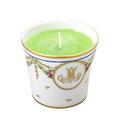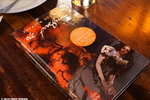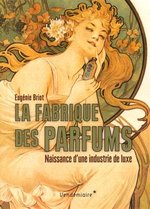Fragrant Reading: Book Review of A Scented Palace by Elisabeth de Feydeau: The Intertwined Destinies of Marie-Antoinette & Her Perfumer, Jean-Louis Fargeon
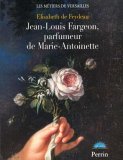
This is a review of the French edition of A Scented Palace by Elisabeth de Feydeau. In French it bears the title, Jean-Louis Fargeon, parfumeur de Marie-Antoinette (éditions Perrin & Le Château de Versailles, 2004, 230 pages). It was published in the collection "Les Métiers de Versailles" which showcases such little-known yet critical personalities as the gardener of Louis XV and the wet-nurse of Louis XV. The English edition will be available in the United States on June 22. It can be pre-ordered now on Amazon.
The book retraces the biographical intinerary of Jean-Louis Fargeon, the scion of a dynasty of perfumers, from the time of his birth until his final escape from the guillotine. Elisabeth de Feydeau follows his career and professional relationship with Marie-Antoinette and leaves him on the day of his release from a revolutionary prison on 27 July 1794 (9 Thermidor an II), the day that marked the end of the reign of Terror with the arrest of Robespierre. He dies twelve years later, in 1806, still a successful perfumer and a fragrance supplier, amongst others, of Joséphine de Bauharnais, the wife of Napoleon...
The structure of the book is built around the metaphor of a three-tiered perfume (a slight anachronism?) and is thus divided into three parts, the top notes (1748-1774), the heart notes (1774-1782), and the base notes (1782-1794). In the first part we are offered insights into the training of an apothecary-perfumer of that era in the southern city of Montpellier. At that time, neighboring Grasse is gaining more and more economic importance, progressively overshadowing Montpellier. The family business as a result is languishing and so the ambitious young Fargeon decides upon reading an article in the Mercure de France relating the arrival of Marie-Antoinette of Austria in France and her marriage to the Dauphin that he will become her perfumer. He leaves for Paris at the beginning of 1773.
We are under the reign of Louis XV, an era so enamored with perfumes that the court was nicknamed "the perfumed court". The Parisian salons strike foreigners like the count of Fersen in 1774 as being exquisitely scented abodes. It is a very opportune time therefore for Fargeon to try to establish himself as a court perfumer. Madame du Barry, the mistress of Louis XV, famous for her profligate love of perfumes will be his first important patron at the court. The reader follows with delight descriptions of the notes found in the perfumes that Fargeon brought her the first time they met, such as the Eau de Cypre Composée and Eau Sensuelle.
Not long after this first encounter, Louis XV dies and Louis XVI and Marie-Antoinette ascend to the throne. Fargeon worries that his association with the Comtesse du Barry will be held against him by the new queen. Despite these fears, he manages to be introduced to Marie-Antoinette thanks to the Princesse de Guéménée. He decides to demonstrate his know-how to the young queen by preparing perfumed leather gloves as the queen likes to ride and is a great consummer of these accessories. It is also a specialty of his home-town Montpellier.
Along the book, we are offered descriptions of court life as well as of the everyday life of a Parisian perfumer.
The look into Marie-Antoinette's life is sometimes very intimate. For example, we learn that after one of her pregnancies she started losing her hair and requested some help from Fargeon as he also made cosmetics, creams, and all sorts of plant preparations. We are also informed of the details of her bathing ritual.
Regarding Fargeon, we learn about the types of products he made and the techniques he used and developed, such as enfleurage and distillation. His access to the status of master in his profession of maître gantier-parfumeur is also documented and interesting. We learn that he succeeded in the final examination of his skills by perfecting the scenting of a type of material that was used to cover desks, and, as a bonus, he also came up with the idea of a large scented pouch meant to hold a lady's nightgown during the day to perfume it.
The second part ends with the episode of Marie-Antoinette ordering a custom-made perfume from Fargeon that would recreate the scents and atmosphere of her beloved Trianon. Just before the visit ends on that day, she also asks him to make a scent for a man, "a virile man, if ever there was one", secretly alluding to the Count of Fersen, her paramour (the relationship remained a platonic one it seems). He thus composes for her two scents, one of them being the Parfum du Trianon which was recreated by Francis Kurkdjian in 2005 and renamed, M.A. Sillage de la Reine.
The third part shows the first signs that the French Revolution is upcoming and we follow the progressive demise of Marie-Antoinette. A notable episode is the last meeting between Fargeon and the queen on the eve of the royal family's escape through Varenne. She wants to see him to request that her perfume flacons be refilled. She is wearing the Parfum du Trianon and Fargeon notices how the tuberose has become sickly-smelling on her skin, conveying a sense of foreboding to him. He also notices that the aroma of the masculine scent he composed for her mysterious male acquaintance is still lingering in the room.
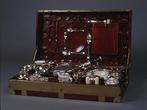
Elisabeth de Feydeau proposes us to consider the possibility that the royal family was caught precisely because Marie-Antoinette was wearing a perfume, a detail that, supposedly, might have given her out. A variation on this thesis is that a servant at the inn they stayed caught a whiff of the perfumes in Marie-Antoinette's luggage and realizing that the queen had stocked-piled on toiletries, guessed, correctly, that she was not leaving just for a short trip. This is a recurring story that is often circulated, but de Feydeau does not bring new evidence to make it leave the realm of speculation.
The author writes well and has enough historical imagination to make the past come vividly alive. Her focus on the sense of smell to describe Versailles or Paris brings up many interesting olfactory observations. For example, we are able to smell 18th century Versailles through Fargeon; he reports that once one stepped away from the stench of the latrines, there was a characteristic aroma, a slightly rancid note floating on a peppery and musky background that was unique to Versailles. The perfume amateur will also enjoy the level of detail that the author brings to the descriptions of the scents created by Fargeon and of the raw materials he used. However, the frontier between fictionalization and rigorous historical account is not always very definite so that in the end one may decide to just read the book as a fictionalized historical account. This is not to say that historical information is lacking, quite to the contrary, but, for example, there are not enough notes to guide the reader in his assessment of the factuality of the data that is offered in the book. Conversations and trains of thought are reported, but we are uncertain sometimes as to the sources for certain passages in the book.
One would have also liked to see in what ways Jean-François Houbigant might have had an impact on the two principal characters of the book, or not. He is a little bit like the elephant in the room since he is usually recognized as Marie-Antoinette's personal perfumer and is much better-known than Fargeon. Perhaps Houbigant will be the object of a separate book. He is not mentioned once in this one, which is a bit surprising, even if only to explain why he is not part of the historic narrative.
The book is informative and very pleasant to read. It rests upon original archival research. It is not a meager feat to establish a historiography of the scented society since the data will be dispersed and marginal most of the time. This book succeeds in making you think that it is a worthwhile endeavor and that more original research is needed to develop that particular type of historiography. It suggests an orientation of research which would enable the available historical material to be less repetitive and limited as well as pull it further away from folklore.
Photos: French edition of A Scented Palace; Marie-Antoinette's travel case from the Musée de Grasse; a reproduction of an 18th century candle holder decorated with Marie-Antoinette's monogram -- it is available for sale here.







